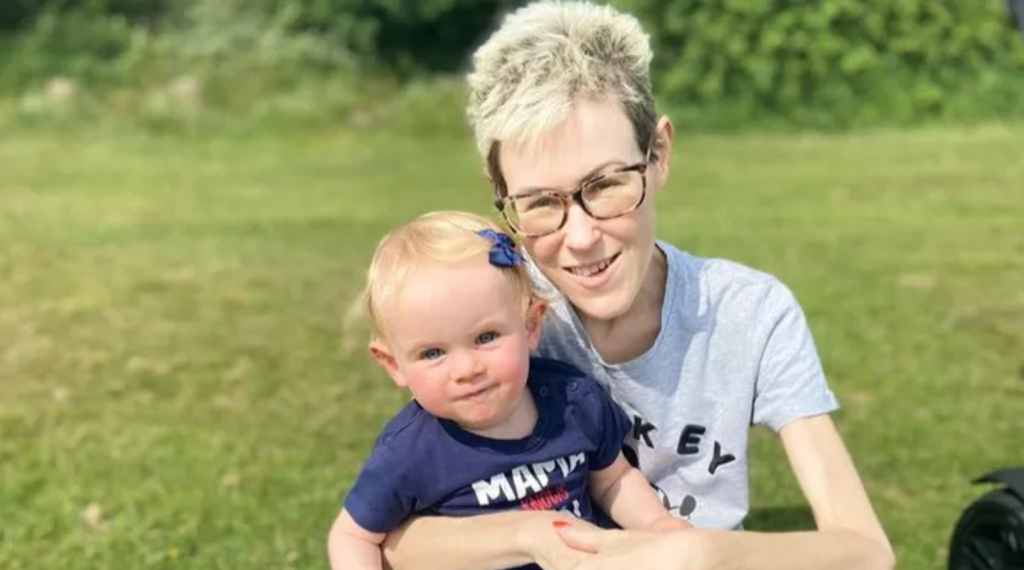Praying for a Second Miracle
- Expectant mother Kelly Butler, 40, had tried for a child with her husband Dave for years and even turned to IVF, but then wound up conceiving naturally. Six months later she found out she had cancer.
- At 27 weeks pregnant with her “miracle child,” the overjoyed mom-to-be went in for a routine blood test and then her world turned upside down: she was diagnosed with an atypical chronic myeloid leukemia (CML), which starts in the blood-forming cells of the bone marrow.
- Doctors advised Kelly to have the baby 4 weeks early. Listening to her care team, she fortunately gave birth to a healthy baby girl: Milly May, born in November 2020.
- With CML, the bone marrow is making too many white blood cells. CML is a generally a slow-growing cancer, but it can evolve into a fast growing acute-leukemia.
Expectant mother Kelly Butler, 40, had tried for a child with her husband Dave for years and even turned to IVF, but then wound up conceiving naturally. Six months later she found out she had cancer.
Read More
'I Always Knew I Wanted to be a Mommy' Cancer Survivor Stephanie Virgin's Stor
Kelly underwent a bone marrow transplant, which unfortunately was not successful, and was told a second try would not be possible.
Family and friends are not giving up. Asking for a “2nd Miracle,” in reference to her first with baby Milly, they set up a GoFundMe for the brave mother, now 42. Generous donations have poured in well past $30,000 so far for the hopeful family. Kelly’s longtime friend Sandra Clarke spoke on behalf of the cancer warrior to BirminghamLive.
“We’re up against the clock really. Her white blood cells are stable at the moment which is great,” she shared. “Kelly and Dave have sent off letters to doctors all over the world.”
“We don’t know what treatment she’ll need or how much it will cost so we just want to raise as much as we can so we’re ready once something becomes available.”
Stay Positive, It Matters
What is Chronic Myeloid Leukemia (CML)?
With CML, the bone marrow is making too many white blood cells. CML is a generally a slow-growing cancer, but it can evolve into a fast growing acute-leukemia.
When someone has CML, a genetic change takes place in immature versions of myeloid cells, which create red blood cells, platelets, and most types of white blood cells. This change forms an abnormal gene called BCR-ABL, which turns into a CML cell. These cells then build up in the bone marrow and spill over into the blood. They can eventually spread to other parts of the body.
Understanding Chronic Myeloid Leukemia (CML)
Some common indicators of CML are:
- Weakness
- Fatigue
- Night sweats
- Weight loss
- Fever
- Bone pain
- A sense of fullness after small amounts of food
Some of these symptoms are linked to leukemia cells replacing the bone-marrow's normal cells, which results in there not being enough red blood cells, functioning white blood cells, or platelets. This can cause problems like anemia.
Diagnosing CML
If your doctor suspects you may have a myeloproliferative neoplasm (MPN), they will conduct a series of tests in order to get a proper diagnosis and determine what treatment route to take.
Those tests may include:
- Complete blood count (CBC): to look for hemoglobin, different types of white blood cells, and platelets
- Serum Erythropoietin: a blood test that is usually low in polycythemia vera
- Blood smear to examine blood sample under a microscope
- Bone marrow examination: This will involve taking a small sample of the bone marrow and looking at it under a microscope to determine the amount of cancer & if there is a mutation and/or chromosomal abnormality
- Quantitative Polymerase Chain Reaction (qPCR): This is the most sensitive test that detects and measures the quantity of the mutated gene (BCR-ABL1) gene in blood or bone marrow samples
There are other factors that play into the treatment plan after a diagnosis is established, such as the phase of the disease, the patient's age and overall health, the availability of a stem cell donor, and more.
Treatment Options
In the early phases of the disease (chronic/early stage), CML is often treated with a type of drug called tyrosine kinase inhibitors (TKIs). These kill the abnormal CML gene in the blood and can control the disease for years.
When a person is diagnosed at a later stage, they can also be treated with TKIs. For patients who are not responding appropriately to TKI therapy, there is the possibility of using a type of immunotherapy called interferon alfa or to receive a bone marrow transplant, or a type of immunotherapy called interferon alfa. Your doctor may also suggest a combination of therapies.
People who are diagnosed in the "blast" phase typically experience a disease that behaves more like an acute leukemia. Unfortunately, the treatment options are limited. There is some potential for TKIs in this phase as well, and some patients may be able to try a stem cell transplant. Most patients with this type of CML cannot be cured, so doctors may suggest a palliative care (reducing symptoms rather than curing the disease) approach instead.
Learn more about SurvivorNet's rigorous medical review process.


